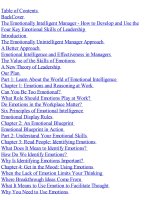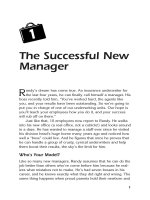The one minute manager
Bạn đang xem bản rút gọn của tài liệu. Xem và tải ngay bản đầy đủ của tài liệu tại đây (540.49 KB, 96 trang )
This Berkley book contains the complete text of the original hardcover
edition.
THE ONE MINUTE MANAGER
A Berkley Book / published by arrangement with William Morrow and
Company, Inc.
PRINTING HISTORY William Morrow and Company edition
published 1982 Berkley trade paperback edition / October 1983
All rights reserved. Copyright © 1981, 1982 by Blanchard Family
Partnership and Candle Communications Corporation. This book may
not be reproduced in whole or in part, by mimeograph or any other
means, without permission. For information address: William Morrow
and Company, Inc. 105 Madison Avenue, New York, New York
10016.
ISBN: 0-425-09847-8
A BERKLEY BOOK ® TM 757,375 Berkley Books are published by
The Berkley Publishing Group, 200 Madison Avenue, New York, New
York 10016. The name “BERKLEY” and the “B” logo are trademarks
belonging to Berkley Publishing Corporation. PRINTED IN THE
UNITED STATES OF AMERICA
50 49 48
2
Contents
The Search
The One Minute Manager
The First Secret: One Minute Goals
One Minute Goals: Summary
The Second Secret: One Minute Praisings
One Minute Praisings: Summary
The Appraisal
The Third Secret: One Minute Reprimands
One Minute Reprimands: Summary
The One Minute Manager Explains
Why One Minute Goals Work
Why One Minute Praisings Work
Why One Minute Reprimands Work
A Gift to Yourself
A Gift to Others
Acknowledgments
About the Authors
3
The Symbol
The One Minute Manager‟s symbol—a one minute
readout from the face of a modern digital watch— is
intended to remind each of us to take a minute out of our
day to look into the faces of the people we manage. And
to realize that they are our most important resources.
Introduction
In this brief story, we present you with a great deal of
what we have learned from our studies in medicine and in
the behavioral sciences about how people work best with
other people.
By “best,” we mean how people produce valuable results,
and feel good about themselves, the organization and the
other people with whom they work.
This allegory, The One Minute Manager, is a simple
compilation of what many wise people have taught us and
what we have learned ourselves. We recognize the
importance of these sources of wisdom. We also realize
that the people who work with you as their manager will
look to you as one of their sources of wisdom.
We trust, therefore, that you will take the practical
knowledge you gain from this book and use it in your
daily management. For as the ancient sage, Confucius,
advises each of us: “The essence of knowledge is, having
it, to use it.”
We hope you enjoy using what you learn from The One
Minute Manager and that, as a result, you and the people
you work with will enjoy healthier, happier and more
productive lives.
Kenneth Blanchard, Ph.D.
Spencer Johnson, M.D.
4
5
This page intentionally left blank
6
The Search
ONCE there was a bright young man who was looking for
an effective manager.
He wanted to work for one. He wanted to become one.
His search had taken him over many years to the far
corners of the world.
He had been in small towns and in the capitals of
powerful nations.
He had spoken with many managers: with government
administrators and military officers, construction
superintendents and corporate executives, university
presidents and shop foremen, utility supervisors and
foundation directors, with the managers of shops and
stores, of restaurants, banks and hotels, with men and
women—young and old.
He had gone into every kind of office, large and small,
luxurious and sparse, with windows and without.
He was beginning to see the full spectrum of how people
manage people.
But he wasn‟t always pleased with what he saw.
He had seen many “tough” managers whose organizations
seemed to win while their people lost.
Some of their superiors thought they were good
managers.
Many of their subordinates thought otherwise.
7
As the man sat in each of these “tough people‟s” offices,
he asked, “What kind of a manager would you say you
are?”
Their answers varied only slightly.
“I‟m an autocratic manager—I keep on top of the
situation,” he was told. “A bottom-line manager.” “Hard-
nosed.” “Realistic.” “Profit-minded.”
He heard the pride in their voices and their interest in
results.
The man also met many “nice” managers whose people
seemed to win while their organizations lost.
Some of the people who reported to them thought they
were good managers.
Those to whom they reported had their doubts.
As the man sat and listened to these “nice” people answer
the same question, he heard,
“I‟m a democratic manager.” “Participative.”
“Supportive.” “Considerate.” “Humanistic.”
He heard the pride in their voices and their interest in
people.
But he was disturbed.
It was as though most managers in the world were
primarily interested either in results or in people.
The managers who were interested in results often
seemed to be labeled “autocratic,” while the managers
interested in people were often labeled “democratic.”
The young man thought each of these managers—the
“tough” autocrat and the “nice” democrat—were only
8
partially effective. “It‟s like being half a manager,” he
thought.
He returned home tired and discouraged.
He might have given up his search long ago, but he had
one great advantage. He knew exactly what he was
looking for.
“Effective managers,” he thought, “manage themselves
and the people they work with so that both the
organization and the people profit from their presence.”
The young man had looked everywhere for an effective
manager but had found only a few. The few he did find
would not share their secrets with him. He began to think
maybe he would never find out what really made an
effective manager tick.
Then he began hearing marvelous stories about a special
manager who lived, ironically, in a nearby town. He heard
that people liked to work for this man and that they
produced great results together. The young man wondered
if the stories were really true and, if so, whether this
manager would be willing to share his secrets with him.
Curious, he telephoned the special manager‟s secretary
for an appointment. The secretary put him through
immediately.
The young man asked this special manager when he could
see him. He heard, “Any time this week is fine, except
Wednesday morning. You pick the time.”
The young man quietly chuckled because this supposedly
marvelous manager sounded like a “kook” to him. What
9
kind of manager had that kind of time available? But the
young man was fascinated. He went to see him.
10
The One Minute Manager
WHEN the young man arrived at the manager‟s office, he
found him standing and looking out of the window. When
the young man coughed, the manager turned and smiled.
He invited the young man to sit down and asked, “What
can I do for you?”
The young man said, “I‟d like to ask you some questions
about how you manage people.”
The manager willingly said, “Fire away.”
“Well, to begin with, do you hold regularly scheduled
meetings with your subordinates?”
“Yes, I do—once a week on Wednesdays from 9:00 to
11:00. That‟s why
I couldn‟t see you then,” responded the manager.
“What do you do at those meetings?” probed the young
man.
“I listen while my people review and analyze what they
accomplished last week, the problems they had, and what
still needs to be accomplished. Then we develop plans
and strategies for the next week.”
“Are the decisions made at those meetings binding on
both you and your people?” questioned the young man.
“Of course they are,” insisted the manager. “What would
be the point of having the meeting if they weren‟t?”
“Then you are a participative manager, aren‟t you?” asked
the young man.
“On the contrary,” insisted the manager, “I don‟t believe
in participating in any of my people‟s decision-making.”
“Then what is the purpose of your meetings?”
“I already told you that,” he said. “Please, young man, do
not ask me to repeat myself. It is a waste of my time and
yours.
11
“We‟re here to get results,” the manager continued. “The
purpose of this organization is efficiency. By being
organized we are a great deal more productive.”
“Oh, so you‟re aware of the need for productivity. Then
you‟re more results-oriented than people-oriented,” the
young man suggested.
“No!” the manager resounded, startling his visitor. “I hear
that all too often.” He got to his feet and began to walk
about. “How on earth can I get results if it‟s not through
people? I care about people and results. They go hand in
hand.
“Here, young man, look at this.” The manager handed his
visitor a plaque.
“I keep it on my desk to remind me of a practical truth.”
12
People Who Feel
Good About
Themselves
Produce
Good Results
13
As the young man looked at the plaque, the manager said,
“Think about yourself. When do you work best? Is it
when you feel good about yourself?
Or when you don‟t?”
The young man nodded as he began to see the obvious. “I
get more done when I‟m feeling good about myself,” he
responded.
“Of course you do,” the manager agreed. “And so does
everyone else.”
The young man raised his index finger with new-found
insight. “So,” he said, “helping people to feel good about
themselves is a key to getting more done.”
“Yes,” the manager agreed. “However, remember
productivity is more than just the quantity of work done.
It is also the quality.” He walked over to the window and
said, “Come over here, young man.”
He pointed to the traffic below and asked, “Do you see
how many foreign cars there are on the road?”
The young man looked out at the real world, and said, “I
see more of them every day. And I guess that‟s because
they‟re more economical and they last longer.”
The manager nodded reluctantly and said “Exactly. So
why do you think people are buying foreign cars?
Because American manufacturers did not make enough
cars? Or,” the manager said without interrupting,
“because they did not make the quality car the American
public really wanted?
“Now that I think of it,” the young man answered, “it‟s a
question of quality and quantity.”
14
“Of course,” the manager added. “Quality is simply
giving people the product or service they really want and
need.”
The older man stood at the window lost in his thoughts.
He could remember, not so long ago, when his country
provided the technology that helped to rebuild Europe and
Asia. It still amazed him that America had fallen so far
behind in productivity.
The young man broke the manager‟s concentration. “I‟m
reminded of an ad I saw on television,” the visitor
volunteered. “It showed the name of the foreign car, and
over it came the words If you’re going to take out a long-
term car loan, don’t buy a short-term car.”
The manager turned and said quietly, “I‟m afraid that‟s a
rather good summary. And that‟s the whole point.
Productivity is both quantity and quality.”
The manager and his visitor began to walk back towards
the couch. “And frankly, the best way to achieve both of
these results is through people.”
The young man‟s interest increased. As he sat down, he
asked, “Well, you‟ve already said that you‟re not a
participative manager. Just how would you describe
yourself?”
“That‟s easy,” he responded without hesitation. “I‟m a
One Minute Manager.”
The young man‟s face showed surprise. He‟d never heard
of a One Minute Manager. “You‟re a what?”
15
The manager laughed and said, “I‟m a One Minute
Manager. I call myself that because it takes very little
time for me to get very big results from people.”
Although the young man had spoken with many
managers, he had never heard one talk like this. It was
hard to believe. A One Minute Manager— someone who
gets good results without taking much time.
Seeing the doubt on his face the manager said, “You don‟t
believe me, do you? You don‟t believe that I‟m a One
Minute Manager.”
“I must admit it‟s hard for me even to imagine,” the
young man responded.
The manager laughed and said, “Listen, you‟d better talk
to my people if you really want to know what kind of
manager I am.”
The manager leaned over and spoke into the office
intercom. His secretary, Ms. Metcalfe, came in moments
later and handed the young man a sheet of paper.
“Those are the names, positions and phone numbers of
the six people who report to me,” the One Minute
Manager explained.
“Which ones should I talk to?” the young man asked.
“That‟s your decision,” the manager responded. “Pick any
name. Talk to any one of them or all of them.”
“Well, I mean who should I start with?”
“I already told you, I don‟t make decisions for other
people,” the manager said firmly. “Make that decision
yourself.” He stood up and walked his visitor towards the
door.
16
“You have asked me, not once, but twice, to make a
simple decision for you. Frankly, young man, I find that
annoying. Do not ask me to repeat myself. Either pick a
name and get started, or take your search for effective
management elsewhere.”
The visitor was stunned. He was uncomfortable, very
uncomfortable. A moment of embarrassed silence seemed
like an eternity.
Then the One Minute Manager looked the young man in
the eye and said,
“You want to know about managing people, and I admire
that.” He shook his visitor‟s hand.
“If you have any questions after talking to some of my
people,” he said warmly, “come back and see me. I
appreciate your interest and desire to learn how to
manage. I would, in fact, like to give you the concept of
the One Minute Manager as a gift. Someone gave it to me
once and it‟s made all the difference to me. I want you to
understand it fully. If you like it, you may want to become
a One Minute Manager yourself someday.”
“Thank you,” the young man managed.
He left the manager‟s office somewhat dumbfounded. As
he passed the secretary she said understandingly, “I can
see from your dazed look that you‟ve already experienced
our One Minute Manager.”
The young man said very slowly, still trying to figure
things out, “I guess
I have.”
17
“Maybe I can help you,” Ms. Metcalfe said. “I‟ve phoned
the six people who report to him. Five of them are here
and they have each agreed to see you. You may be better
able to understand our „One Minute Manager‟ after
you‟ve spoken with them.”
The young man thanked her, looked over the list and
decided to talk to three of them: Mr. Trenell, Mr. Levy
and Ms. Brown.
18
The First Secret: One Minute Goals
WHEN the young man arrived at Trenell‟s office, he
found a middle-aged man smiling at him. “Well, you‟ve
been to see the „ole man.‟ He‟s quite a guy, isn‟t he?”
“He seems that way,” the young man responded.
“Did he tell you about being a One Minute Manager?”
“He sure did. It‟s not true, is it?” asked the young man.
“You‟d better believe it is. I hardly ever see him.”
“You mean you never get any help from him?” puzzled
the young man.
“Essentially very little, although he does spend some time
with me at the beginning of a new task or responsibility.
That‟s when he does One Minute Goal Setting.” “One
Minute Goal Setting. What‟s that?” said the young man.
“He told me he was a One Minute Manager, but he didn‟t
say anything about One Minute Goal Setting.”
“That‟s the first of the three secrets to One Minute
Management,” Trenell answered.
“Three secrets?” the young man asked, wanting to know
more.
“Yes,” said Trenell. “One Minute Goal Setting is the first
one and the foundation for One Minute Management. You
see, in most organizations when you ask people what they
do and then ask their boss, all too often you get two
different lists. In fact, in some organizations I‟ve worked
in, any relationship between what I thought my job
responsibilities were and what my boss thought they
19
were, was purely coincidental. And then I would get in
trouble for not doing something I didn‟t even think was
my job.”
“Does that ever happen here?” asked the young man.
“No!” Trenell said. “It never happens here. The One
Minute Manager always makes it clear what our
responsibilities are and what we are being held
accountable for.”
“Just how does he do that?” the young man wanted to
know.
“Efficiently,” Trenell said with a smile.
Trenell began to explain. “Once he has told me what
needs to be done or we have agreed on what needs to be
done, then each goal is recorded on no more than a single
page. The One Minute Manager feels that a goal, and its
performance standard, should take no more than 250
words to express. He insists that anyone be able to read it
within a minute. He keeps a copy and I keep a copy so
everything is clear and so we can both periodically check
the progress.
“Do you have these one-page statements for every goal?”
“Yes,” answered Trenell.
“Well, wouldn‟t there be a lot of these one-page
statements for each person?”
“No, there really aren‟t,” Trenell insisted. “The old man
believes in the 80-20 goal-setting rule. That is, 80% of
your really important results will come from 20% of your
goals. So we only do One Minute Goal Setting on that
20%, that is, our key areas of responsibility—maybe three
20
to six goals in all. Of course, in the event a special project
comes up, we set special One Minute Goals.”
“Interesting,” the young man commented. “I think I
understand the importance of One Minute Goal Setting. It
sounds like a philosophy of „no surprises‟—everyone
knows what is expected from the beginning.”
“Exactly,” Trenell nodded.
“So is One Minute Goal Setting just understanding what
your responsibilities are?” the young man asked.
“No. Once we know what our job is, the manager always
makes sure we know what good performance is. In other
words, performance standards are clear. He shows us
what he expects.”
“How does he do that—show you what he expects?”
asked the young man.
“Let me give you an example,” Trenell suggested.
“One of my One Minute Goals was this: Identify
performance problems and come up with solutions which,
when implemented, will turn the situation around.
“When I first came to work here I spotted a problem that
needed to be solved, but I didn‟t know what to do. So I
called the One Minute Manager.
When he answered the phone, I said, Sir, I have a
problem. Before I could get another word out, he said,
Good! That’s what you’ve been hired to solve.
Then there was a dead silence on the other end of the
phone.
21
“I didn‟t know what to do. The silence was deafening. I
eventually stuttered out, But, but, Sir, I don’t know how to
solve this problem.
“Trenell, he said, one of your goals for the future is for
you to identify and solve your own problems. But since
you are new, come on up and we’ll talk.
“When I got up there, he said, Tell me, Trenell, what your
problem is— but put it in behavioral terms.
“Behavioral terms? I echoed. What do you mean by
behavioral terms?
“I mean, the manager explained to me, that I do not want
to hear about only attitudes or feelings. Tell me what is
happening in observable, measurable terms.
“I described the problem the best I could.
“He said, That’s good, Trenell! Now tell me what you
would like to be happening in behavioral terms.
“I don’t know, I said.
“Then don’t waste my time, he snapped.
“I just froze in amazement for a few seconds. I didn‟t
know what to do.
He mercifully broke the dead silence.
“If you can’t tell me what you’d like to be happening, he
said, you don’t have a problem yet. You’re just
complaining. A problem only exists if there is a difference
between what is actually happening and what you desire
to be happening.
“Being a quick learner, I suddenly realized I knew what I
wanted to be happening. After I told him, he asked me to
22
talk about what may have caused the discrepancy between
the actual and the desired.
“After that the One Minute Manager said, Well, what are
you going to do about it?”
“Well, I could do A, I said.
“If you did A, would what you want to happen actually
happen? he asked.
“No, I said.
“Then you have a lousy solution. What else could you do?
He asked.
“I could do B, I said.
“But if you do B, will what you want to happen really
happen? He countered again.
“No, I realized.
“Then, that’s also a bad solution, he said. What else can
you do?
“I thought about it for a couple of minutes and said, I
could do C. But if I do C, what I want to happen won’t
happen, so that is a bad solution, isn’t it? “Right. You’re
starting to come around, the manager then said, with a
smile on his face. Is there anything else you could do? he
asked.
“Maybe I could combine some of these solutions, I said.
“That sounds worth trying, he reacted.
“In fact, if I do A this week, B next week and C in two
weeks, I’ll have it solved. That’s fantastic. Thanks so
much. You solved my problem for me.
“He got very annoyed. I did not, he interrupted, you
solved it yourself. I just asked you questions—questions
23
you are able to ask yourself. Now get out of here and start
solving your own problems on your time, not mine.
“I knew what he had done, of course. He‟d shown me
how to solve problems so that I could do it on my own in
the future.
“Then he stood, looked me straight in the eye and said,
You‟re good, Trenell. Remember that the next time you
have a problem.
“I remember smiling as I left his office.” Trenell leaned
back in his chair and looked as if he were reliving his first
encounter with the One Minute Manager.
“So,” the young man began, reflecting on what he had
just heard.
24
One Minute Goals: Summary
One Minute Goal Setting is simply:
1. Agree on your goals.
2. See what good behavior looks like.
3. Write out each of your goals on a single sheet of
paper using less than 250 words.
4. Read and re-read each goal, which requires only a
minute or so each time you do it.
5. Take a minute every once in a while out of your
day to look at your performance, and
6. See whether or not your behavior matches your
goal.









